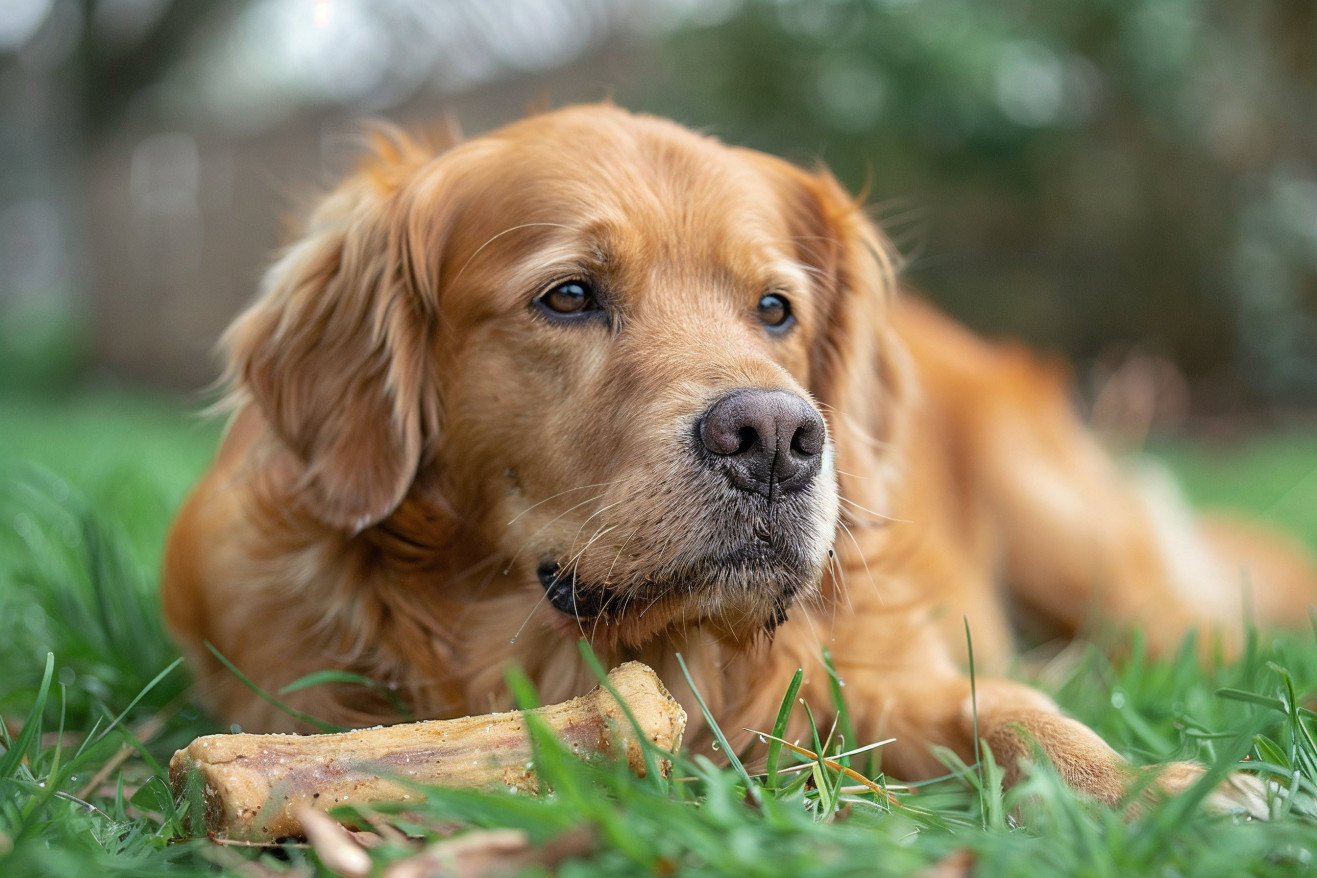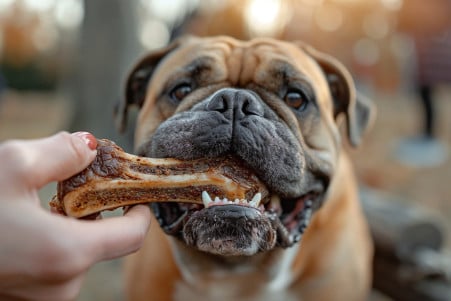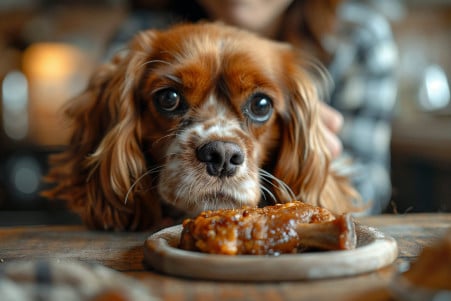Can Dogs Eat Lamb Bones? Safety and Nutritional Guide
6 March 2024 • Updated 6 March 2024

If you want to spoil your furry friend with a lamb bone, there are some things you need to know. Raw lamb bones are safe to give to dogs and can even help with dental health, but there are some caveats. Cooked bones should be avoided at all costs, as they can splinter and cause damage or blockages. And, of course, you should always monitor your dog while they’re eating a bone.
This article will take a deep dive into veterinary opinions, nutritional information, and research on dog diets to give you a complete picture of what happens when dogs eat lamb bones. By the end, you’ll understand how your dog’s digestive system works in relation to the nutrients in lamb bones, so you can make the best choices for your dog’s health.
Can dogs eat lamb bones?
What Do Lamb Bones Do for Dogs?
Dogs need a diet that is high in protein to help maintain muscle mass and calcium to support bone health.
Bones have always been a natural part of a dog’s diet, providing essential nutrients and dental benefits.
The raw feeding movement, which some dog owners have adopted, recommends raw meaty bones as an essential part of a dog’s diet.
Lamb bones, which are a natural source of protein and calcium, may offer specific nutritional advantages that help meet a dog’s dietary requirements.
For raw feeders, lamb bones are part of a whole food approach to their pets’ diet, even though those who feed their dogs commercial diets may disagree.
However, whether you’re feeding lamb bones or any other kind of bone, it’s important to make sure that they are part of a nutritionally balanced and safe diet. It’s also important to note that while lamb bones can be a valuable addition to a dog’s diet, they don’t provide everything a dog needs. Knowing the nutritional benefits and make-up of lamb bones can help you decide where they fit in a balanced diet.
Nutritional Benefits of Lamb Bones
Lamb bones are more than just a source of entertainment; they also offer a variety of nutrients that can help your dog. PetMD explains that the marrow is high in fat and blood components, although not technically bone, which makes it a high-energy snack.
The bones are made up of about one-third organic and two-thirds inorganic material, with calcium phosphate making up the majority of the inorganic part. This means that lamb bones are a good source of calcium and phosphorus, which are both important minerals for a dog’s bone health.
It’s important to note that when it comes to a balanced diet, lamb bones are a good source of minerals, but they don’t contain vitamins, fatty acids, enzymes, proteins, or carbohydrates. This makes them more of a supplement than a complete food source. The meat and connective tissues that are still attached to the bones also provide some nutritional value, including protein and possibly other nutrients.
Because of their limited nutritional value, lamb bones should be used to supplement a balanced diet, not replace it. While they do offer some benefits, it’s important to understand how lamb bones fit into a dog’s overall nutritional needs. As we explore the nutritional value of lamb bones, it’s important to understand how a dog’s digestive system works to process these bones.
How Dogs Digest Bones
Dogs have a digestive system that has evolved to be able to process a wide range of foods, including bones. The digestive system of the dog, as explained by the Veterinary Teaching Hospital at Washington State University, from the mouth to the colon, is well-suited to digesting and absorbing the nutrients in their diet, including the minerals in bones.
However, not all bone fragments are digestible, and those that aren’t can lead to serious health problems, including obstructions or perforations in the digestive system.
As noted in a study in PMC by Sylvain Denis, the size of a dog can affect its digestive physiology and, therefore, its ability to digest bones. Smaller dogs may have a harder time digesting larger or denser bones than larger dogs. VCA Animal Hospitals also notes that bones that are too large or too hard can lead to broken teeth, injuries in the mouth, and digestive obstructions.
While pet owners can help reduce the risks by choosing the right size of bones and avoiding cooked bones, which can splinter, as the Veterinary Teaching Hospital at Washington State University explains, the dog’s digestive system is well-suited to digesting many types of bones.
That said, the safe consumption of bones for dogs is a balance between understanding the digestive system’s natural abilities and the dangers that some types of bones can pose.
Historical Context: The History of Dog Diets and Bone Feeding
Throughout history, dogs have been closely associated with human societies, eating our food and adapting to our dietary habits.
For example, the dogs of ancient Romans were fed a diet that included milk-soaked barley bread and table scraps, with war dogs even being fed raw meat and garlic to increase their strength, reflecting the cultural association between diet and physical prowess.
According to Northwest Naturals, dogs in medieval Europe, from royalty to peasants, were fed diets that included bones and organ meats, although the quality of these foods varied. However, the introduction of commercial pet foods in the 18th and 19th centuries began to change this.
The introduction of kibble in the 20th century was a major shift away from the raw meat and bones dogs had eaten for thousands of years. According to The Bones & Co., kibble is a new development that stands in stark contrast to the historical norm of dog diets. As the pet food industry grew, the convenience of the diets it offered became more important than the ancestral raw diet dogs had eaten for centuries.
Today, while some proponents argue for a return to raw feeding, including feeding dogs bones, others have raised concerns about the potential health risks of this practice, citing worries about the influence of the pet food industry, per Wikipedia.
This historical background helps to explain why the question of whether or not it’s safe to feed dogs lamb bones remains a topic of debate, showing the complicated relationship between tradition, commercialization, and our current knowledge of dog nutrition and health.
Mindful Feeding: Lamb Bones and Your Dog’s Health
If you are thinking about giving your dog lamb bones, the most important thing to consider is your dog’s safety. Hepper explains that lamb bones, especially when cooked, can pose a number of risks, including serious health problems like internal injuries and blockages.
If you choose to give your dog a raw lamb bone, make sure you are watching them closely and that the bone is the right size. Also, make sure you put the bone on a surface that can be easily cleaned to avoid bacterial contamination.
Instead of raw bones, there are other options that are safer, like dental chews and toys that are designed to help clean your dog’s teeth without the risk of splintering. Rover.com also notes that you should be on the lookout for signs of distress, including choking and digestive issues, after your dog has eaten bones.
Before you give your dog any bones, including lamb bones, make sure you talk to your vet about the safest options. A vet can offer personalized advice based on your dog’s size, breed, and health history. For example, Pupford recommends lamb tripe treats as a healthy, lower-risk option for dogs with some of the most common meat allergies.
In the end, the most important things to remember about giving your dog lamb bones are to be careful, talk to your vet, and make sure you are considering other, safer, vet-recommended dietary options.
Making the Choice: Raw Lamb Bones for Dogs
Spoiled Hounds makes a strong case for raw lamb bones, emphasizing their natural dental benefits and the essential amino acids they contain that can help support a dog’s immune system. However, Fetch! Pet Care and Purina agree with us that the risks of cooked bones are too great, including the dangers of splintering, choking, and blockages.
The potential benefits of lamb bones are clear, especially when it comes to dental health and nutrition when they are raw and given with supervision. However, the potential risks are also clear, and they should be taken into account. Making an informed choice requires understanding of both the historical uses and the modern veterinary advice from canine nutrition experts.
In summary, while adding lamb bones to a dog’s diet can be a way to honor their roots as carnivores, it’s important to balance that with safety. It’s important to work with a vet to make sure you’re meeting your dog’s individual dietary needs and to safely incorporate lamb bones into their diet to ensure a happy, healthy pet.


